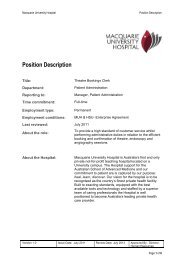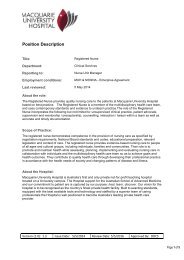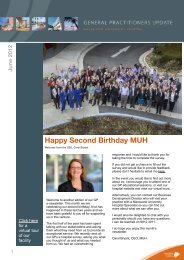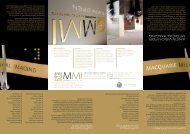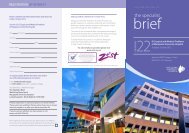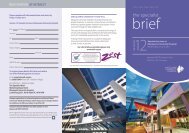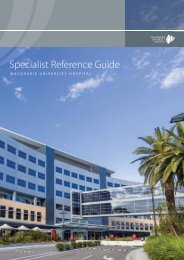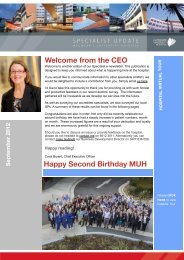Plenary Oral Presentations - Macquarie University Hospital
Plenary Oral Presentations - Macquarie University Hospital
Plenary Oral Presentations - Macquarie University Hospital
Create successful ePaper yourself
Turn your PDF publications into a flip-book with our unique Google optimized e-Paper software.
16 th International Meeting of the Leksell Gamma Knife ® SocietyMarch 2012, Sydney, AustraliaBE-141Gamma knife radiosurgery for NF2 associated vestibularschwannomas - The role of higher dose and cochlearimplantation to rehabilitate hearing.1,2Michael Link, 1,3 Bruce Pollock, 2,1 Colin Driscoll, 3 Robert Foote1Dept. of Neurologic Surgery, Mayo Clinic2Dept. of Otorhinolaryngology, Mayo Clinic3Dept. of Radiation Oncology, Mayo ClinicObjective: The purpose of this review was to evaluate the long-term outcome of NF2 associatedvestibular scwannomas (VS) treated with Gamma Knife stereotactic radiosurgery (GKRS). Specifically,we wanted to examine the rate of tumor control, and hearing preservation, and examine the role ofcochlear implantation to rehabilitate hearing in patients after GKRS.Methods: Between 1990 and 2010 32 VS in 26 patients were treated with GKRS. There were 10women. The median age of the 26 patients was 37 years (range: 13 – 68 years). The median clinicaland imaging follow-up was 85 months (range 3 – 253 months).The median marginal dose was 14 Gy (range 12 – 20 Gy) and the median maximum prescribed dosewas 28 Gy (24 – 40 Gy). The median tumor diameter in the posterior fossa was 15 mm (range 6 – 28mm) and the median treatment volume was 2.65 c.c. (range 0.4 – 11.2 c.c.).Four patients have undergone cochlear implantation (CI) following GKRS.Results: After a median follow-up of ~7 years 18 tumors (56%) were smaller with a median tumorreduction of 5 mm. Eight tumors (25%) remained unchanged in size and 6 tumors (19%)were clearly larger compared to the date of radiosurgery and had shown growth on more than onefollow-up MRI scan. The median marginal dose for the tumors that decreased in volume was15.5 Gy and the median marginal dose for the tumors that showed progressive enlargement was13 Gy.Prior to GKRS 13 treated ears had AAO-HNS Class A or B hearing. In 6 patients an “only hearingear” was treated. At last follow-up only 3/13 (23%) kept Class A or B hearing (PTA < 50 dB; WRS >50%).Two of the four patients who received CI following GKRS have had excellent hearing rehabilitation.Reasons for this will be discussed.Conclusions: GKRS for NF2 associated VS provides an opportunity for tumor control at higher dosesthan usually recommended for sporadic VS but is a poor hearing preservation strategy. However, CIfollowing GKRS, when performed soon after treatment and before a long duration of deafness mayresult in good hearing rehabilitation.10



